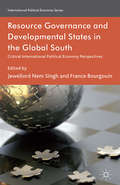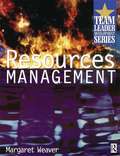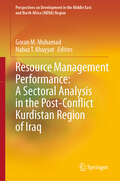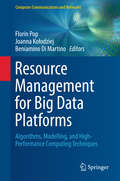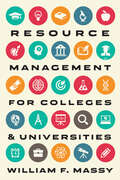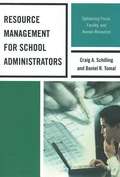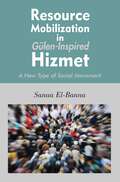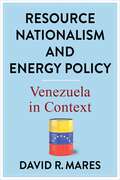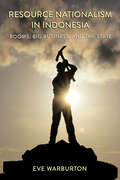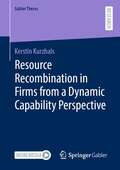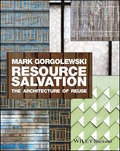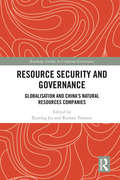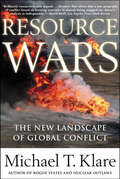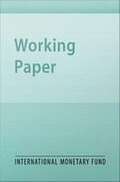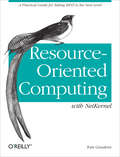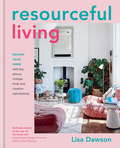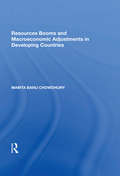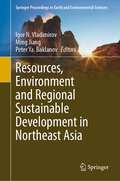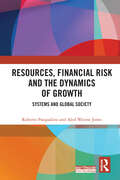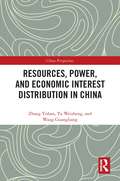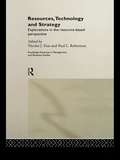- Table View
- List View
Resource Governance and Developmental States in the Global South
by Jewellord Nem Singh F. BourgouinThe political economy landscape has shifted as multinational corporations increase their investment efforts, changing the geographies of extraction. The contributors make the argument for the need of new theoretical perspectives anchored in critical political economy to address structural dynamics in the global industry.
Resource Management
by Margaret WeaverManaging Resources is the absolute guide to all areas of resource control. It includes:* Thorough coverage of all areas of resource control for supervisors.* Clear explanations of theories and techniques of control.* Practical exercises to reinforce skills and knowledge.* Application of theory to the work-based problem's facing today's managers. The Team Leader Development Series is an essential tool towards gaining the Supervisory Management Award. Consisting of four practical and interactive textbooks, this series will be invaluable not only to students, but also as a guide individuals and organisations seeking to improve their business performance at the first level of management.Key learning features:* Learning Objectives to enable the reader to assess the knowledge gained throughout the series.* Activities to put the learning into practice.* Case studies - 'true-life' scenarios!* Workbased Assignments which will provide evidence for S/NVQ portfolios.* Language is straightforward and direct, contextualised to relate to team leaders and supervisory managers working in a wide range of industry sectors.* Influential protagonists in the field will be alluded to as appropriate to support the learning.* Action plan to take the learning forward.
Resource Management Performance: A Sectoral Analysis in the Post-Conflict Kurdistan Region of Iraq (Perspectives on Development in the Middle East and North Africa (MENA) Region)
by Nabaz T. Khayyat Goran M. MuhamadThis book investigates the intricacies of resource management performance across various sectors within the Kurdistan Region of Iraq. With 13 in-depth studies, it examines the region's evolution from an agricultural society to an emerging market since the collapse of the Saddam Hussein regime in 2003. Oil and gas revenue, comprising over 85 percent of fiscal revenues, has attracted multinational companies and international humanitarian organizations, although external factors such as the ISIS conflict and global economic downturns have hindered their performance. Additionally, conflicts with Baghdad and the fallout of the ISIS war have led to double embargoes and economic crises, exacerbated by the region's provision for 2 million refugees and internally displaced persons. International entities like the IOM and UNDP have played vital roles in supporting the region's development amid these challenges. Despite these obstacles, the Kurdistan Region demonstrates significant economic potential. By scrutinizing resource management in sectors such as education and electricity, this book offers valuable insights and policy recommendations for researchers, decision-makers, and organizations invested in the region's growth and stability.
Resource Management for Big Data Platforms
by Joanna Kołodziej Beniamino Di Martino Florin PopServing as a flagship driver towards advance research in the area of Big Data platforms and applications, this book provides a platform for the dissemination of advanced topics of theory, research efforts and analysis, and implementation oriented on methods, techniques and performance evaluation. In 23 chapters, several important formulations of the architecture design, optimization techniques, advanced analytics methods, biological, medical and social media applications are presented. These chapters discuss the research of members from the ICT COST Action IC1406 High-Performance Modelling and Simulation for Big Data Applications (cHiPSet). This volume is ideal as a reference for students, researchers and industry practitioners working in or interested in joining interdisciplinary works in the areas of intelligent decision systems using emergent distributed computing paradigms. It will also allow newcomers to grasp the key concerns and their potential solutions.
Resource Management for Colleges and Universities
by William F. MassyHow comprehensive activity-based models can help university leaders and faculty reshape their institutions through better resource management.Resources in higher education steer colleges and universities both strategically and tactically. They drive incentives and accountability for faculty and staff while providing academics with the infrastructure they need in order to perform effectively. But while American colleges and universities remain the gold standard for worldwide higher education, Resource Management for Colleges and Universities argues that their decision-making cultures and business models are beset by serious flaws. In this audacious book, William F. Massy writes that resource allocation in colleges and universities needs to become more responsive to academic mission, marketplace realities, and the requirements of financial sustainability. Such improvement is needed, he asserts, because few institutions currently have the evidence, know-how, and cultural capacity to take advantage of modern information systems and models. Luckily, today's academic resourcing models enable academic leaders and faculty to close the gaps and do a significantly better job of controlling costs and improving academic performance. Massy describes three kinds of contemporary, comprehensive AR models: internal economic, external economic, and mission-market-margin. He explains how these models, if used correctly, support mission-critical academic decisions and reveals why they are game-changers for college and university management. Describing how real universities are using these models to understand their teaching and research revenues and costs and to predict changes needed in budget planning, Massy also provides numerous insights about how academic organizations function and how they can be induced to adopt needed changes. Building on Reengineering the University, Massy's earlier book, Resource Management for Colleges and Universities will provide readers with the wherewithal, and the motivation, to fundamentally transform their institutions.
Resource Management for School Administrators: Optimizing Fiscal, Facility, and Human Resources
by Daniel R. Tomal Craig A. SchillingResource Management for School Administrators is the only comprehensive book covering all school resources---fiscal, facilities and human resources. Each chapter has objectives that are aligned with the new ELCC and ISLCC standards on accreditation. Many of the federal and various state policies and laws are included. Everything you need to know on managing school resources are covered: national and state perspectives, future challenges to funding public education, resource allocation, developing a school district budget, sources of revenue, accounting budgeting and reporting, financial statements, allocating resource for higher student performance, human resource, laws and policies, compensation, facilities and auxiliary services and safety and security <P><P>Each chapter contains a comprehensive case study and exercises for easy application. This practical book will be useful to all school leaders who are trying to improve their school resource management.
Resource Mobilization in Gulen-Inspired Hizmet
by Sanaa El-BannaThis scholarly book presents a case study of some of the London-based work of a social movement known as Hizmet, or the Gulen Movement. This transnational faith-inspired movement represents a rising trend of philanthropic social activism around the world and increasingly now in the Muslim world. This book grew out of the author's deep interest in Muslims' interaction with modern society, their social activism, and their response and contributions to global transformation. The author provides a unique insight into the Hizmet Movement, how it draws on Islamic resources, how it should be classified, and how it differs from other social movements.
Resource Nationalism and Energy Policy: Venezuela in Context (Center on Global Energy Policy Series)
by David R. MaresIt is widely thought that state ownership of natural resources, oil and natural gas in particular, causes countries to fall under the sway of the “resource curse.” In such cases, governments allegedly display “resource nationalism,” which destabilizes the economy, society, and politics. In this book, David R. Mares dispels these beliefs and develops a powerful new account of the relationship between state resource ownership and energy policy.Mares examines variations in energy policy across a wide range of countries, underscoring the fact that in most of the world outside the United States, subsoil natural resources are owned by the state. He considers the history of Latin American oil and gas policies and provides an in-depth analysis of Venezuela from 1989 to 2016—before, during, and after the presidency of Hugo Chávez. Mares demonstrates that the key factors that influence energy policy are the inclusiveness of the political system, the level of competitiveness within policy making, and the characteristics of individual leaders. Domestic politics, not state ownership, determines the effectiveness and efficiency of energy policies: the “resource curse” is avoidable. Drawing on these findings, Mares reconceptualizes resource nationalism, arguing that government intervention into resource extraction is legitimate as long as the benefits are shared through the provision of public goods. Featuring a sophisticated grasp of both Latin American politics and energy policy, this book sheds new light on why some governments are responsible stewards of natural resources while others appropriate national wealth for partisan or private benefit.
Resource Nationalism in Indonesia: Booms, Big Business, and the State
by Eve WarburtonIn Resource Nationalism in Indonesia, Eve Warburton traces nationalist policy trajectories in Indonesia back to the preferences of big local business interests. Commodity booms often prompt more nationalist policy styles in resource-rich countries. Usually, this nationalist push weakens once a boom is over. But in Indonesia, a major global exporter of coal, palm oil, nickel, and other minerals, the intensity of nationalist policy interventions increased after the early twenty-first-century commodity boom came to an end. Equally puzzling, the state applied nationalist policies unevenly across the land and resource sectors. Resource Nationalism in Indonesia explains these trends by examining the economic and political benefits that accrue to domestic business actors when commodity prices soar. Warburton shows how the centrality of patronage to Indonesia's democratic political economy, and the growing importance of mining and palm oil as drivers of export earnings, enhanced both the instrumental and structural power of major domestic companies, giving them new influence over the direction of nationalist change.
Resource Recombination in Firms from a Dynamic Capability Perspective (Gabler Theses)
by Kerstin KurzhalsThis book elaborates the concept of Resource Recombination in firms from a Dynamic Capability perspective. With the investigation of the role of Dynamic Capabilities in the process of innovation generation through Resource Recombination, this research addresses some existing shortcomings in the Dynamic Capability literature, where there is a crucial need to better understand the interrelationship between Dynamic Capabilities, the firm`s resource base, and innovation through Resource Recombinations. This research contributes to the resource and competence based research by developing and empirically testing a conceptual model of factors influencing Resource Recombination in firms. The principal aim of this research is to bring clarity to the notion of Dynamic Capabilities, their role and effects towards building Resource Recombinations in firms.
Resource Regimes: Natural Resources and Social Institutions (Studies in International Political Economy)
by Oran R. YoungThis title is part of UC Press's Voices Revived program, which commemorates University of California Press’s mission to seek out and cultivate the brightest minds and give them voice, reach, and impact. Drawing on a backlist dating to 1893, Voices Revived makes high-quality, peer-reviewed scholarship accessible once again using print-on-demand technology. This title was originally published in 1982.
Resource Salvation: The Architecture of Reuse
by Mark GorgolewskiA valuable source of information, insight, and fresh ideas about a crucial aspect of the growing sustainable design movement Mounting resource shortages worldwide coupled with skyrocketing extraction costs for new materials have made the prospect of materials reuse and recycling an issue of paramount importance. A fundamental goal of the sustainable design movement is to derive utmost use from construction materials and components, including energy, water, materials, building components, whole structures, and even entire infrastructures. Written by an expert with many years of experience in both industry and academe, this book explores a wide range of sustainable design strategies which designers around the globe are using to create efficient and aesthetically pleasing buildings from waste streams and discarded items. Emphasizing performance issues, design considerations and process constraints, it describes numerous fully realized projects, and explores theoretical applications still on the drawing board. There is a growing awareness worldwide of the need for cyclical systems of materials reuse. Pioneering efforts at “closed-loop” design date as far back as 1960s, but only recently have architects and designers begun to focus on the opportunities which discarded materials can provide for creating high performance structures. A source of insight and fresh ideas for architects, engineers, and designers, Resource Salvation: Reviews the theory and practice of building material and waste reuse and describes best practices in that area worldwide Describes projects that use closed-loop thinking to influence and inspire the design of components, interiors, whole buildings, or urban landscapes Illustrates how using discarded materials and focusing on closed loops can lead to new concepts in architecture, building science, and urban design Demonstrates how designers have developed aesthetically compelling solutions to the demands of rigorous performance standards Resource Salvation is a source of information and inspiration for architects, civil engineers, green building professionals, building materials suppliers, landscape designers, urban designers, and government policymakers. It is certain to become required reading in university courses in sustainable architecture, as well as materials engineering and environmental engineering curricula with a sustainable design component.
Resource Security and Governance: Globalisation and China’s Natural Resources Companies (Routledge Studies in Corporate Governance)
by Xinting Jia Roman TomasicChina’s phenomenal economic growth in the past 30 years has witnessed the rise of its global natural resources companies. At the same time, the emerging of a middle class in China and their desire to improve living standards including better dwelling conditions, better health and nutrition, has driven strong demand in mineral resources, energy and quality food. The so called ‘socialist market economy’ in China has seen this growing demand being met partially by companies with ‘national significance’. In the resources sector, these companies are represented by companies listed in stock exchanges in China as well as globally such as in New York and London; at the same time, most of these companies are also controlled by the Chinese government. China’s resources companies have expanded overseas in search of new acquisition targets whilst seeking to extend their global reach with a focus on resource rich countries. The expansion of these companies internationally, and the unique ownership structure of these companies, has posed challenges for regulators, trading partners of these companies, investors and other interested parties seeking to understand how these companies are governed and the implications of government ownership for resource security globally. Resource Security and Governance: The Globalisation of China’s Natural Resources Companies contains case studies of the global expansion efforts of Chinese global natural resources companies; it reviews the governance structures of these companies and analyses how these have affected the inter-relationship between these companies and their trading partners, governments, regulators in targeted countries and investors globally. In addition, this book examines how the unique structure of these companies may affect resource security globally and touches on other related matters such as climate change, and air and water security in China.
Resource Wars: The New Landscape of Global Conflict
by Michael T. KlareThis sobering look at the future of warfare predicts that conflicts will now be fought over diminishing supplies of our most precious natural resources.From the barren oilfields of Central Asia to the lush Nile delta, from the busy shipping lanes of the South China Sea to the uranium mines and diamond fields of sub-Saharan Africa, Resource Wars looks at the growing impact of resource scarcity on the military policies of nations. International security expert Michael T. Klare argues that in the early decades of the new millennium wars will be fought not over ideology but over resources, as states battle to control dwindling supplies of precious natural commodities. The political divisions of the Cold War, Klare asserts, are giving way to an immense global scramble for essential materials, such as oil, timber, minerals, and water. And as armies throughout the world define resource security as their primary mission, widespread instability is bound to follow, especially in those places where resource competition overlaps with long-standing disputes over territorial rights.A much-needed assessment of a changed world, Resource Wars is a compelling look at the future of warfare in an era of heightened environmental stress and accelerated economic competition.
Resource Windfalls and Emerging Market Sovereign Bond Spreads: The Role of Political Institutions
by Rabah Arezki Markus BrücknerA report from the International Monetary Fund.
Resource-Oriented Computing with NetKernel: Taking REST Ideas to the Next Level
by Tom GeudensTake resource-oriented computing out for a spin with this hands-on introduction to NetKernel, and discover how ROC can improve the way you design and implement software and software systems. Learn how ROC’s new approach combines core ideas from the REST architectural style with the Unix development model. By using NetKernel to create and then string simple services together, you can develop complex systems that scale as easily as the Internet does. Author Tom Geudens helps you create several NetKernel modules right away, and then walks you through the results to demonstrate their effectiveness.Create, test, and document Netkernel modules from scratchLearn the basic principles of ROC’s abstract computing modelDesign an interface in NetKernel that lets you insert, update, delete, and select actions in MongoDBUse the Visualizer to trace information about root requests processed by NetKernelHandle resource requests with DPML—NetKernel’s Declarative-Request Process Markup LanguageCompose modular XML documents with the XML Recursion Language (XRL)Build solutions using nCoDE in NetKernel’s visual editor
Resource: How Acquisitions and Their Consequences Affect Consumer Thinking
by Gerald Zaltman Lindsay ZaltmanThe deep metaphor of resource relates to capacities or abilities that we use to restore or achieve certain states. This chapter explores how consumers view the world through the lens of resource.
Resourceful Living
by Lisa DawsonIt's often thought that restyling your space comes with a hefty price tag and unavoidable waste. But in Resourceful Living, award-winning interiors blogger Lisa Dawson shows how, with a little creativity, you can revamp your home with existing pieces, vintage finds and key purchases. The clever ideas in this beautiful book cover:- The most important ways we use our homes, from eating to sleeping, living and working.- The Basics of steering clear of interiors 'fast fashion', multi-purposing furniture and making the most of what you have.- Styling Your Home with simple solutions for re-imagining each room, from gallery walls to home bars, repainted storage to retro accessories.Including her top ten key vintage buys and tips for in-store and online thrifting, Lisa's inspiring advice shares the fun of creative sourcing as a more sustainable way to keep your home feeling fresh.'Resourceful Living feels like reading a recipe book, not only because of the delicious interiors images, but because of the simple ingredients and easy methods that are shared to achieve beautiful living spaces for yourself.' Melanie Sykes'I've been a long-time fan and follower of Lisa's interiors tips. This book really is super practical as well as beautiful - perfect for anyone looking to be more interiors savvy.' Rachel Khoo
Resources Booms and Macroeconomic Adjustments in Developing Countries
by Mamta Banu ChowdhuryChowdhury addresses fundamental issues of policy management in resource-based developing countries, by providing an extension of the existing 'Dutch Disease' theory and its applications to the developing country context. The impact of resources booms is of paramount importance for the developing economies. To date the analytical and empirical investigations of these issues have not been available. Essentially, this study will fill this gap. The book investigates the macroeconomic impact of a resources boom and the long-term growth implications of related policy choices with reference to Papua New Guinea. Like many other primary commodity exporting developing economies, Papua New Guinea experienced several short-lived export booms over the past two and a half decades, providing a fascinating case study of potential gains from resources booms and the accompanying complex problems of policy management. This study also incorporates a comparative study of resources boom and policy management issues between Papua New Guinea, Indonesia and Nigeria.
Resources, Efficiency and Globalization
by Pavlos Dimitratos Marian V. JonesInternational business for the modern firm has to compromise the need to use limited resources and achieve efficiency in the global marketplace. This book examines these issues from the viewpoint of the internationalized SME, the big multinational and the local subsidiary drawing on research conducted in different countries.
Resources, Environment and Regional Sustainable Development in Northeast Asia (Springer Proceedings in Earth and Environmental Sciences)
by Ming Jiang Igor N. Vladimirov Peter Ya. BaklanovThis book highlights the environmental issues, an assessment of environmental risks within the borders of Northeast Asia and neighboring territories. This book pays special attention to the transboundary factor as the main factor in international and interregional cooperation. This book develops methods of complex, thematic, interpretative mapping, geoinformation modeling, processing of remote sensing data for geographical and environmental studies, models for the analysis of spatial and temporal geographic data, and their long series. The book is planned to widely cover economic, physical–geographical and environmental studies, including the analysis of natural resources from the state of the natural environment and resource potential to its change under the influence of various factors.
Resources, Financial Risk and the Dynamics of Growth: Systems and Global Society
by Roberto Pasqualino Aled Wynne JonesThis book presents a new System Dynamics model (the ERRE model), a novel stock and flow consistent global impact assessment model designed by the authors to address the financial risks emerging from the interaction between economic growth and environmental limits under the presence of shocks. Building on the World3-03 Limits to Growth model, the ERRE links the financial system with the energy, agriculture and climate systems through the real economy, by means of feedback loops, time lags and non-linear rationally bounded decision making. Prices and their interaction with growth, inflation and interest rates are assumed to be the main driver of economic failure while reaching planetary limits. The model allows for the stress-testing of fat tail extreme risk scenarios, such as climate shocks, energy transition, monetary policies and carbon taxes. Risks are addressed via scenario analyses, compared to real available data, and assessed in terms of the economic theory that lies behind. The book outlines the case for a government led system change within this decade, where the market alone cannot lead to sustainable prosperity. This book will be of great interest to scholars of climate change, behavioural, ecological and evolutionary economics, green finance, and sustainable development.
Resources, Power, and Economic Interest Distribution in China (China Perspectives)
by Zhang Yishan Yu Weisheng Wang GuangliangBased on an investigation of economic and resource allocation factors and their close relation to economic power, this book puts forward the power paradigm, a new economic research paradigm revealing the relationship among power, institutions, and resource allocation mechanisms, helping to establish a valid connection between macroeconomics and microeconomics and shedding light on real-world economic issues. Drawing on classical, neoclassical, and institutional economics and how these schools of thought have impacted on economic development in China over the past century, the book sheds light on distribution processes and argues that enterprise contracts, market pricing, policies, laws and regulations can all be classified as interest distribution mechanisms informed by a variety of power games. The power paradigm suggests that to achieve full utility and an optimal allocation of resources to foster social welfare, power reciprocity needs to be shared among different economic agents at the same hierarchy level while making sure that power and responsibility are equivalent for each economic agent. The book will appeal to research students and academics interested in heterodox economics, pluralist approaches, institutional economics, and game theory.
Resources, Production and Structural Dynamics
by Baranzini, Mauro L. and Rotondi, Claudia and Scazzieri, Roberto Mauro L. Baranzini Claudia Rotondi Roberto ScazzieriEconomists since the First Industrial Revolution have been interested in the links between economic growth and resources, often pointing to resource scarcities as a hindrance to growth. Offering a counter perspective, this volume highlights the positive role that scarcities can play in inducing technical progress and economic growth. It outlines a structural framework for the political economy of scarcity and rents, and offers a novel way of organizing the evidence concerning the role of resources in industrial growth. This book proposes a major shift in the treatment of scarcity issues by focusing on bottlenecks and opportunities arising within the production system, and will appeal to economists and policy makers interested in the role of resources as triggers of structural change.
Resources, Technology and Strategy (Routledge Advances in Management and Business Studies)
by Nicolai J. Foss Paul L. RobertsonResources, Technology and Strategy brings together contributors from Europe, North America and Asia to consider the strategic relationship between technology and other resources, such as production capabilities, marketing prowess, finance and organisational culture.Throughout the book, these experts take a critical approach to RBP (Resource-Based Perspective) in order to assess both its strengths and weaknesses. Case studies also highlight the importance of both having and not having strong technological capabilities in settings as diverse as the US semiconductor industry, small family manufacturing firms in Hong Kong and state-owned enterprises in China.
